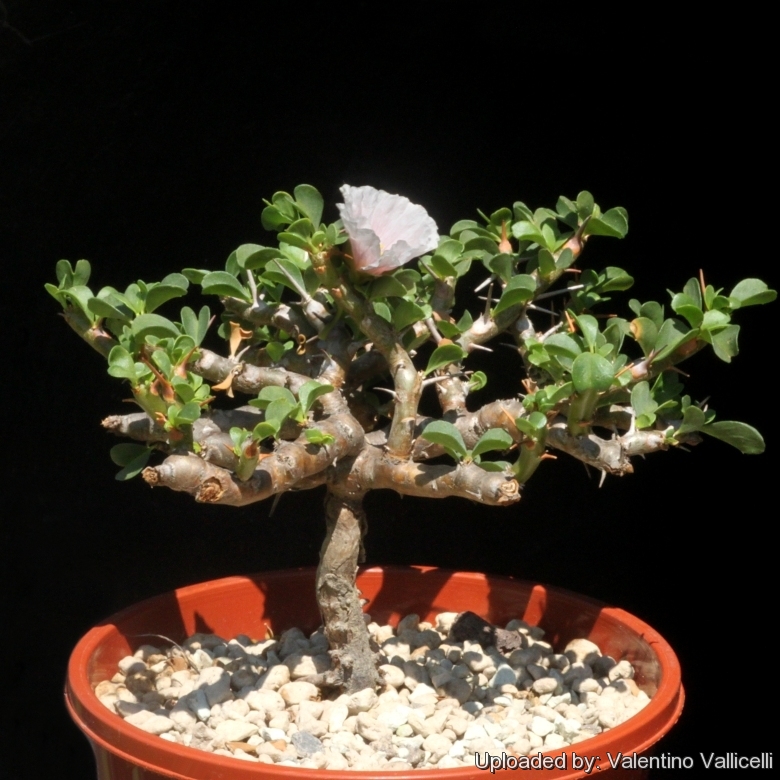




Your support is critical to our success.

Origin and Habitat: Northern Cape, Albany-District , Republic of South Africa.
Altitude: up to 396 m.
Habitat: Grows in the the bushy and dry semi-karoo area of the Fish River valley on rocky hills or mountain sides, in gravel and on outcrops of weathered quartzite.
Synonyms:
- Monsonia vanderietiae (L. Bolus) F.Albers
- Sarcocaulon vanderietiae L. Bolus
ENGLISH: Candle Bush, Bushman's Candle
AFRIKAANS (Afrikaans): Boesmankers, Groot Kersbos
Description: It is a perennial, deciduous, succulent under-shrub, mainly low-growing, with wandering branches, 10-20 cm tall and 25 (or more) cm in diameter, forming a compact, spiny mat of growth in its desert habitat. It will drop it's leaves readily during drought periods and leaf and flower when water is available. The plant resembles a small tree and is very suitable for bonsai but always an attractive plant.
Root: Swollen.
Branches: 0,5-1 cm in diameter, sparsely spined, which grow mostly horizontally close to ground-level, bark dark greyish to olive-green, main trunk 5-8 cm in diameter.
Spines: Thin, straight, rarely more than 25 mm long, base obovate
Leaves: Small, fleshy, leathery, tufted or solitary in the axils of the thorns, bright green , broadly elliptic to heart-shaped 8-10 x 8-10.
Flower: Conspicuous up to 3 cm across (or more), appearing singly. Sepals 5-10 mm long, hairless or finely hairy, with mucro less than 1 mm. Petals five broad, crinkly textured in a saucer shape pink to white.
Blooming season: Autumn to spring.
Bibliography: Major references and further lectures
1) Albers F. “Monsonia” in:Urs Eggli “Illustrated Handbook of Succulent Plants: Dicotyledons” Springer Science & Business Media, 2002
2) Jean-André Audissou “The genus Sarcocaulon (De Candolle) Sweet (1826)” CACTUS-AVENTURES International N° 70
3) Moffett R. O. “The genus Sarcocaulon” in Bothalia Vol. 12, N°. 4 (1979) : 581-612.

Monsonia vanderietiae Photo by: Valentino Vallicelli

Monsonia vanderietiae Photo by: Valentino Vallicelli
Cultivation and Propagation: Sarcocaulon vanderietiaeSN|22903]]SN|22903]] is a decorative plant which has the fame to be difficult to care properly in cultivation, however it is relatively easily grown species, very suitable for bonsai. Seed-grown plants thrive and flower prolifically in cultivation while imported specimens rarely produce an extensive new root system and flower sporadically, but survive for many years.
Exposure: They require direct sunlight when in full growth, while a filtered exposition is best during the hottest period of summer, when the plants enter in their dormancy phase. They always grow best in positions where they receive long periods of strong sunlight
Watering: They need to be regularly watered every 6 to 10 days whilst they are in active growth and and producing leaves, occasionally during dormancy. In cultivation it appear best not to let plants go into dormancy and to water year round. Nevertheless even in habitat the Sarcocaulons appear to be opportunistic and respond to precipitation events when they occur. As soon as the foliage starts to show signs of yellowing or withering, water should be withheld. It is very important that there is plenty of free air circulation around cultivated plants and also that they are not overwatered.
Soil: The ideal cultivation medium is very draining with at least 75% of pumice and lava grit.
Propagation: All Sarcocaulon species are readily grown from seeds. Seeds should be sown just under the surface of the soil, in large seed trays or plastic pots. They should be planted out into individual containers when they are about two years old. The most dangerous period for seedling is in summer. They need to be kept dry whilst dormant but at the same time their trunk do not withstand continual drought. The seedlings adapt to the climate where they are grown and develop a vigorous root system.
| Your Actions | |
|---|---|
| Back to Monsonia index | |
| Back to Geraniaceae index | |
 |
Back to Succulents Encyclopedia index |
Privacy stantement - Terms and conditions - How to cite - About us - Feedback - Donate




